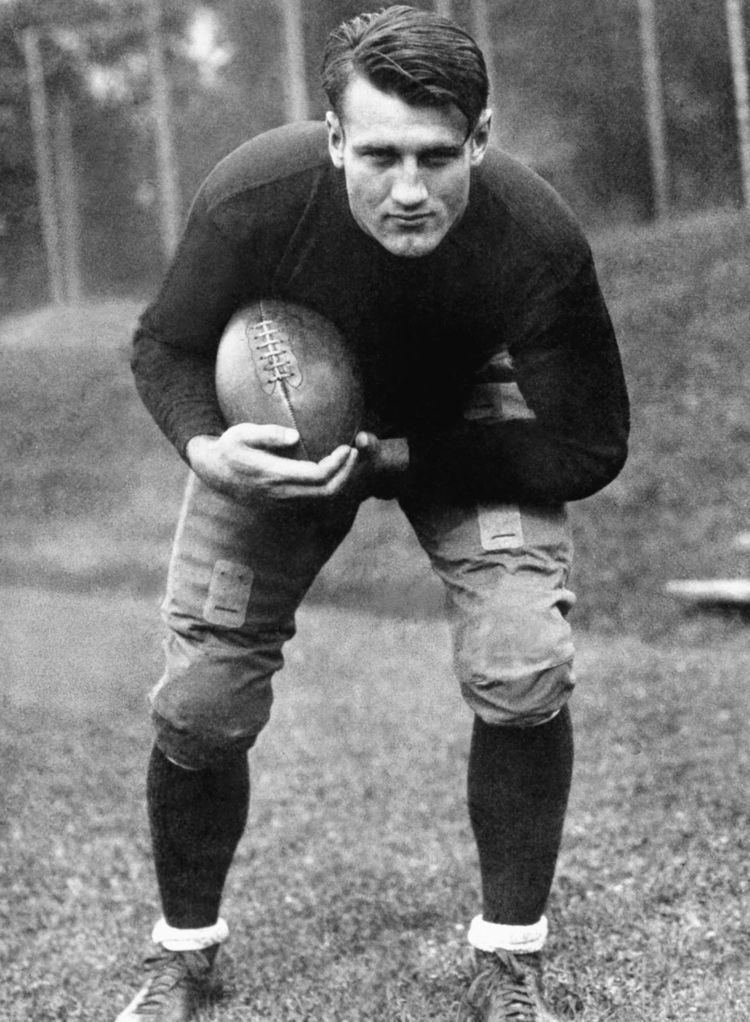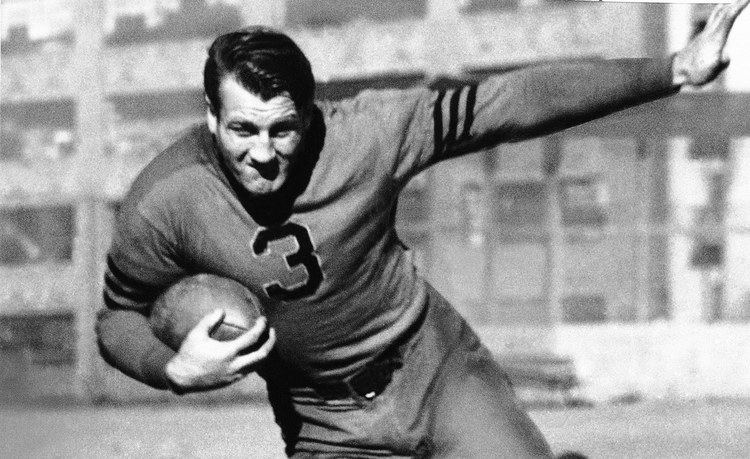Height 1.88 m | Weight: 226 lb (103 kg) Spouse Eileen Kane (m. 1936) Name Bronko Nagurski Children Bronko Nagurski, Jr. | |
 | ||
Date of birth: (1908-11-03)November 3, 1908 Date of death: January 7, 1990(1990-01-07) (aged 81) Awards SI's All-time College All-Stars Similar People Red Grange, Bronko Nagurski - Jr, Chuck Bednarik, Sid Luckman | ||
Aaron Donald | Defensive Player of the Year | 2013 Bronko Nagurski Trophy Winner | PittLiveWire
Three Clemson Players Named to Bronko Nagurski Award Watch List | CampusInsiders
Bronislaum Nagurski (November 3, 1908 – January 7, 1990) was a Canadian-born American football player in the National Football League (NFL), renowned for his strength and size. His parents were from Western Ukraine. Nagurski was also a successful professional wrestler, recognized as a multiple-time World Heavyweight Champion.
Contents
- Aaron Donald Defensive Player of the Year 2013 Bronko Nagurski Trophy Winner PittLiveWire
- Three Clemson Players Named to Bronko Nagurski Award Watch List CampusInsiders
- Youth and collegiate career
- Football
- Wrestling
- Wrestling championships and accomplishments
- Personal life
- Later life
- Legacy
- References

Nagurski became a standout playing both tackle on defense and fullback on offense at Minnesota from 1927 to 1929, selected a consensus All-American in 1929 and inducted into the College Football Hall of Fame in its inaugural year of 1951. His professional career with the Chicago Bears also made him an inaugural inductee into the Pro Football Hall of Fame.

Youth and collegiate career

Nagurski was born in Rainy River, Ontario, Canada, of Ukrainian descent, and his family moved to International Falls, Minnesota, when he was 5 years old. His parents, "Mike" and Michelina Nagurski, were immigrants, from Western Ukraine (Halychyna/Galicia). Young Bronislau grew up working on his parents' farm and sawmill, delivering groceries for his father's grocery store and in his teens laboring at nearby timbering operations, growing into a powerfully muscular 6-footer.

Nagurski was discovered and signed by University of Minnesota head coach Clarence Spears, who drove to International Falls and arriving watched Nagurski out plowing a field. According to legend, Spears asked directions to the nearest town, and Bronko lifted his plow and used it to point in the direction of town. He was signed on the spot to play for the Golden Gophers. Spears admitted he concocted the story on his long drive back to the University of Minnesota in Minneapolis.
Legends aside, on his first day of practice Spears decided to test Nagurski in the "Nutcracker" drill, where a defensive player had to take on two blockers and try to tackle a following ball carrier. On the first drill two All-Big Ten linemen and Herb Joesting charged at Bronko, who promptly split the blockers and drove the big fullback into a blocking dummy. Spears sent in three more players, blew his whistle and watched Bronko produce the same explosive results and after a third try with the same conclusion realized what a super player he had recruited.
Nagurski became a standout playing both tackle on defense and fullback on offense at Minnesota from 1927 to 1929. In 1929, after posting 737 rushing yards, he was a consensus All-American at fullback, and despite playing fewer games at the position also made some All-American teams at tackle. The pre-eminent sportswriter of the day, Grantland Rice, listed him at the two positions in picking his 1929 All-America team. Rice later wrote, "Who would you pick to win a football game - 11 Jim Thorpes - 11 Glen Davises - 11 Red Granges - or 11 Bronko Nagurskis? The 11 Nagurskis would be a mop-up. It would be something close to murder and massacre. For the Bronk could star at any position on the field, with 216 pounds of authority to back him up."
His greatest collegiate game was against the University of Wisconsin in 1928. Wearing a corset to protect cracked vertebrae, he recovered a Badger fumble deep in their territory, then ran the ball six straight times to score the go-ahead touchdown. Later in the same game, he intercepted a pass to seal the victory.
During his time with the Gophers, the team went 18-4-2 and won the Big Ten Conference championship in 1927. Nagurski was inducted into the College Football Hall of Fame in 1951.
Football
Nagurski turned professional to play for the Chicago Bears from 1930 to 1937. At 6-feet-2 inches (1.88 m) and 235 pounds (107 kg), he was a formidable presence, and in his day he was a dominant force, helping the Bears win several division titles and two NFL championships.
Nagurski has the largest recorded NFL Championship ring size at 19½ and wore a size 8 helmet. He was probably the largest running back of his time, bigger than most linemen of the day, often dragging multiple tacklers with him. In a time when players were expected to play on both sides of the ball, he was a standout defensive lineman as well playing a ranging tackle or "The Monster." After an injury, instead of sitting on the bench, he would sometimes be put in as an offensive tackle, making him the only player in NFL history to be named All-Pro at three non-kicking positions. In a 1984 interview with Sports Illustrated writer Paul "Dr. Z" Zimmerman, when asked what position he would play if he were coming up in the present day, he said, "I would probably be a linebacker today. I wouldn't be carrying the ball 20 or 25 times a game."
A time-honored and perhaps apocryphal story about Nagurski is a scoring gallop that he made against the Washington Redskins, knocking two linebackers in opposite directions, stomping a defensive back and crushing a safety, then bouncing off the goalposts and cracking Wrigley Field's brick wall. On returning to the huddle for the extra point try, he reportedly said: "That last guy hit me awfully hard."
Once in a game against the Packers, the Bears prepared to punt, and Green Bay's Cal Hubbard went to Red Grange and said: "I promise not to try to block the kick, Red, but get out of the way so I can get a shot at that Polack." "Grange, glad not to try to block Hubbard for once, obliged. Cal tore through the line, slammed into Nagurski and bounced off. Rising slowly, he turned to Grange and said: "Hey, Red, don't do me any more favors."
At the end of the 1932 season, the Chicago Bears and the Portsmouth Spartans were tied with the best regular-season records. To determine the champion, the league voted to hold its first playoff game. Because of cold weather, the game was held indoors at Chicago Stadium, which forced some temporary rule changes. Chicago won, 9–0. In the fourth quarter of the 1932 game, the Bears scored on a controversial touchdown: Carl Brumbaugh handed the ball off to fullback Nagurski, who pulled up and threw to Red Grange in the end zone for the score. The Spartans argued that Nagurski did not drop back five yards before passing to Grange, but the touchdown stood. The playoff proved so popular that the league reorganized into two divisions for the 1933 season, with the winners advancing to a scheduled championship game. A number of new rule changes were also instituted: the goal posts were moved forward to the goal line, every play started from between the hash marks, and forward passes could originate from anywhere behind the line of scrimmage (instead of the previous five yards behind).
During World War II, professional football teams were short of players and in 1943 Bronko Nagurski returned to the Bears for one season. He scored a touchdown in the Bears' championship victory against the Washington Redskins, served one season as backfield coach for UCLA in 1944 and finally returned to wrestling until his retirement in 1960.
Wrestling
During his football career, he built a second athletic career as a professional wrestler and became a major box-office attraction. Tony Stecher, brother of former world champion Joe Stecher, introduced Nagurski to wrestling in 1933 and became his manager. Nagurski defeated Tag Tagerson in his ring debut. Hitting his peak in the late 1930s, Nagurski won a limited version of the world championship by defeating Dean Detton on June 29, 1937. But he finally achieved full recognition with his first National Wrestling Association world title by defeating Lou Thesz on June 23, 1939. Losing the title to Ray Steele on March 7, 1940, he regained it from Steele one year later on March 11, 1941, but lost it three months later to Sandor Szabo on June 5, 1941.
Wrestling championships and accomplishments
Personal life
Nagurski married his childhood sweetheart Eileen Kane on December 28, 1936. The couple had a child Christmas Day 1937, whom they named after his father. Nagurski's son, Bronko Nagurski Jr., played football at the University of Notre Dame and become an all-star with the Hamilton Tiger-Cats of the Canadian Football League.
Later life
After his retirement from wrestling, he returned home to International Falls and opened a service station. A local legend claims that Nagurski had the best repeat business in town because he would screw customers' gas caps down so tight after filling their tanks that no one else in town could unscrew them. He retired from that in 1978, at the age of 70. He lived out a quiet life on the shores of Rainy Lake on the Canada–US border. He performed the coin toss at Super Bowl XVIII in Tampa, Florida, with Washington Redskins quarterback and co-captain Joe Theismann calling the toss on behalf of his team's co-captains and the captains of the opposing Los Angeles Raiders.
In 1990, he died in International Falls and is buried there in the Saint Thomas Cemetery.
Legacy
Nagurski was elected to the Pro Football Hall of Fame as a charter member on September 7, 1963. At the University of Minnesota-Twin Cities house of his fraternity, Sigma Chi, Nagurski's jersey and Significant Sig recognition certificate are on display. After his death, the town of International Falls honored him by opening the Bronko Nagurski Museum in Smokey Bear Park.
Sports Illustrated named Nagurski one of the four greatest athletes in Minnesota state history; the other three were Dave Winfield, Kevin McHale, and Joe Mauer. In 1993, the Football Writers Association of America created the Bronko Nagurski Trophy, awarded annually to the best defensive player in college football. Notable winners include Warren Sapp, Charles Woodson, Terrell Suggs, Champ Bailey and Derrick Johnson. In 1999 Nagurski was selected by Sports Illustrated as a starting defensive tackle for their "NCAA Football All-Century Team". The other starting defensive tackle on that list was Rich Glover. In 2007, Nagurski was ranked No. 17 on ESPN's Top 25 Players In College Football History list.
In 1999, he was ranked No. 35 on The Sporting News' list of the 100 Greatest Football Players, the highest-ranking foreign-born player. In 2000, he was voted the second-greatest Minnesotan sportsman of the 20th century by the sportswriters of the Star Tribune, coming in behind only Minnesota Twins Hall of Famer Kirby Puckett.
A fictionalized eyewitness account of Nagurski's 1943 comeback is the subject of a dramatic monologue in the 2001 film version of Hearts in Atlantis. The film's screenwriter, William Goldman, repeated much of this rendition from his earlier account of the same story in his novel Magic.
In 2009, Nagurski was an honorary team captain, represented by his son, Bronko Nagurski Jr., at the opening game of TCF Bank Stadium. His home town International Falls high school nickname is the Broncos in his honor.
